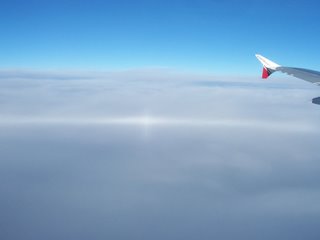The sub-Liljequist 'Parhelion' in high-clouds is rare. On August 14, 2025, a user '太平洋蓝藻'(ID: 516836436) from ' Bilibili.com'(a polular vedio website of China) captured the first record of this event in China during a flight over the Yellow Sea. the sub-Parhelic Circle and sub-120° Parhelion were captured at the same time.
What makes this particularly remarkable is that on left of sub-Liljequist 'Parhelion' in the photograph shows a distinct blue tint, suggesting the possible presence of 'sub-Liljequist Blue Spot'. Pinson HUANG from the Chinese halo watching community was the first to identify this possibility and made the initial simulations. I refined the simulation parameters based on HUANG's work, and the results showed a good alignment with the photograph. SUN Hao Xuan(孙浩轩) and Jing Xiang from the Chinese halo watching community assisted in image authorization and joined in the related research process. KiloNova(千新星), SONG Xi Pei and QIAN Kun from the same community provided crucial information in the analyses of flight data and lens characteristics.
The photograph was taken at 16:43:26 (UTC+8). Based on the CZ5855's flight information(N37.96, E122.98) retrieved from https://flightadsb.variflight.com for that specific time, it can be further concluded that the solar altitude was 22.3 degrees.
 |
| The unevenness of cloud layer should be considered as the cause of the unevenness of the sub-PC, but some simulation results quite support the existence of the sub-Liljequist. |


.jpg)
USM.jpg)
USM%20+%20High%20pass.jpg)


























